Today, we’re diving into the world of racing line in SimRacing, guided by our Setup and Telemetry Specialist and Coach, Massimo Zecchinelli.
What Will You Learn?
- Fundamental Concepts of Racing Lines: Learn to understand each corner perfectly.
- Ideal Line vs. Geometric Line: Discover the crucial differences and which one to apply, illustrated with practical examples.
Why Is It So Important?
Drawing the correct racing line is more than just a skill.
It’s an art that separates good drivers from true champions.
If you want to improve your lap times and achieve exceptional results, this article is a great starting point.
Let's get started!

The Goal of the Racing Line and Reference Points
As you know, to be fast and competitive, the goal every driver must achieve in a corner is clear.
Minimize the time spent in the corner, take it at the highest possible speed, and accelerate as soon as possible.
This maximizes speed on the straights.
It’s a clear objective but not an easy one to achieve.
Optimizing this element means sacrificing something else.
Simply put, to get the best lap times, a driver should sacrifice more speed in the corner for speed on the straight and vice versa.
This depends on:
- Track layout
- Car characteristics
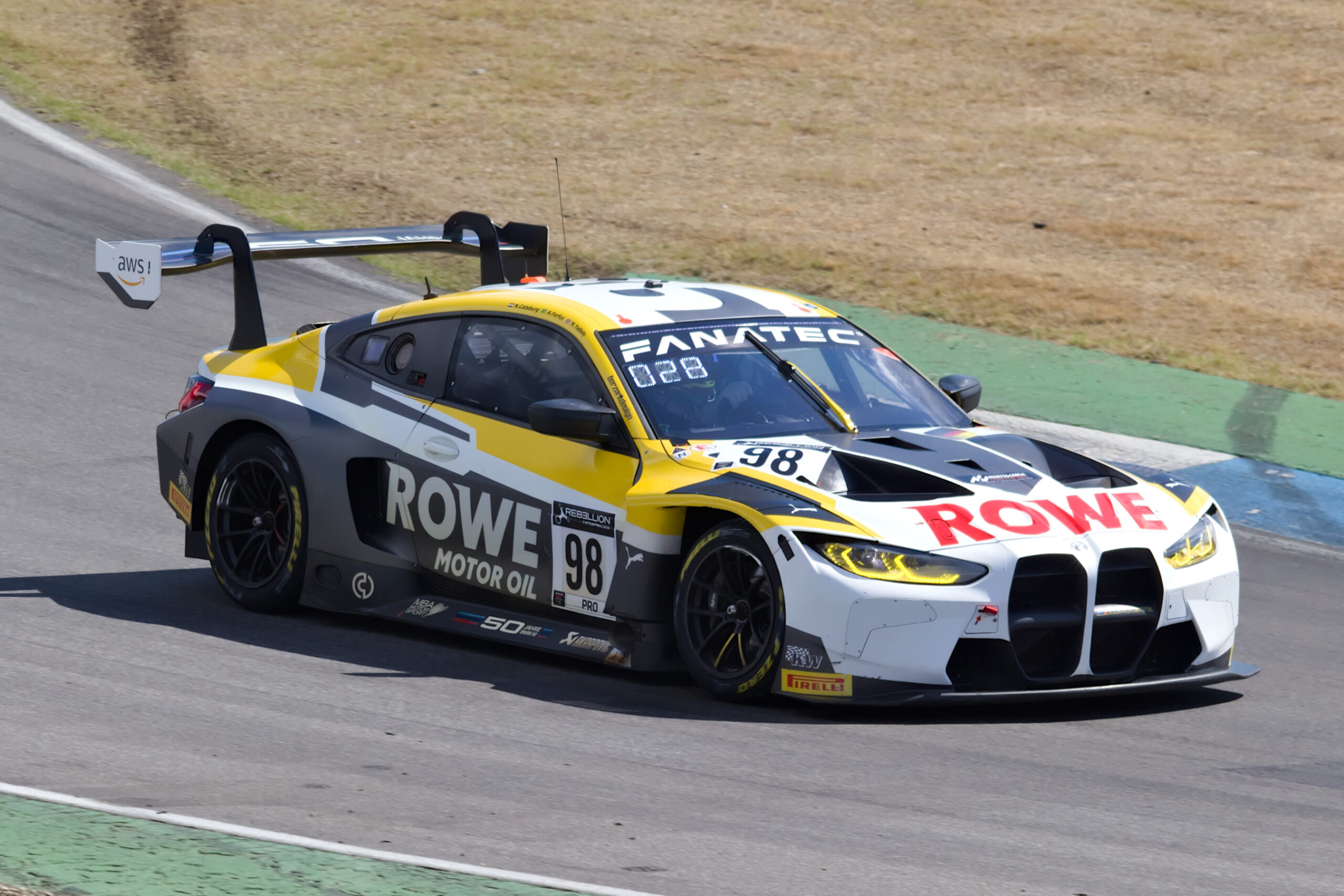
The trick is to determine the best line, keeping in mind the overall lap time.
Consider the corners and straights as one problem, rather than focusing solely on how to take a single corner.
This is the ideal approach to consistently finding the optimal line.
You must consider the type of vehicle you’re driving and the track variables, such as:
- Lengths of straights before and after corners
- Corner angle
- Corner radius
- Presence of negative or positive banking

It’s also essential to note reference points.
These help the driver stay focused on driving and the vehicle’s feedback.
Ideal reference points can be anything on or off the track:
- Mark or crack on the asphalt
- Curb
- Change in asphalt color
- Mark on a wall
- Billboard on the trackside...
The most important thing is to choose reference points that don’t move, break, or change during the race.

Avoid:
- Shadows, which change depending on weather and time
- Distance markers that can be knocked over during the race
For markers, consider those placed higher up.
They can't be destroyed or moved.
They’re perfect.
Ideally, have reference points on both sides of the track and as high as possible from the asphalt.
This is important because, sometimes, with rain obstructing visibility or a dirty bumper, it might be challenging to spot the reference in time.
The same goes when you’re drafting another car, which can reduce visibility.
On certain tracks or simulators, you can also use sound.
For example, when the car passes close to a wall, the exhaust noise changes.
These references are perfect in low visibility conditions.
The driver can always rely on them to navigate a corner effectively.
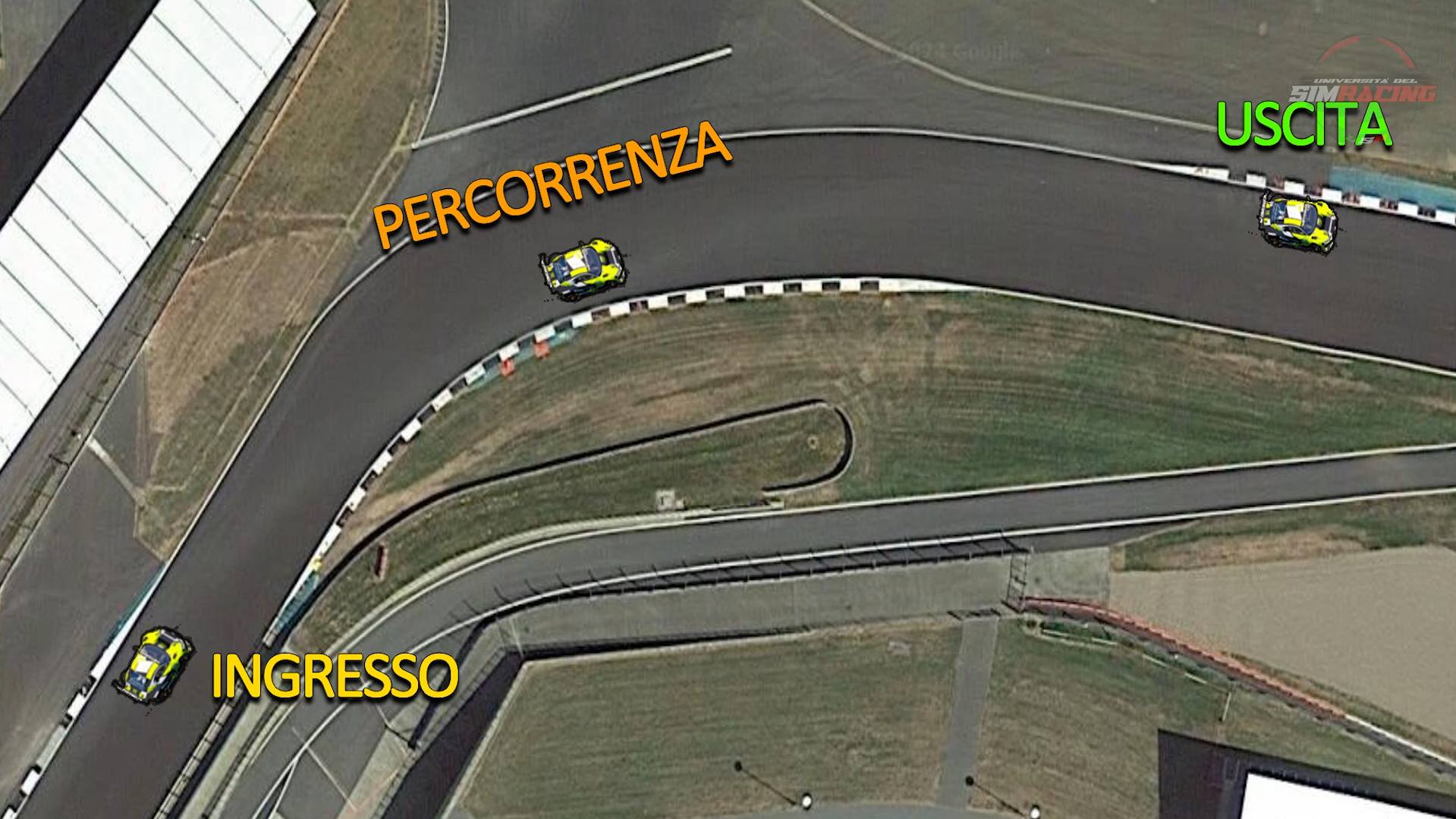
How to Break Down a Corner
It's ideal to divide a turn into three major phases:
- Entry
- Mid-Corner
- Exit
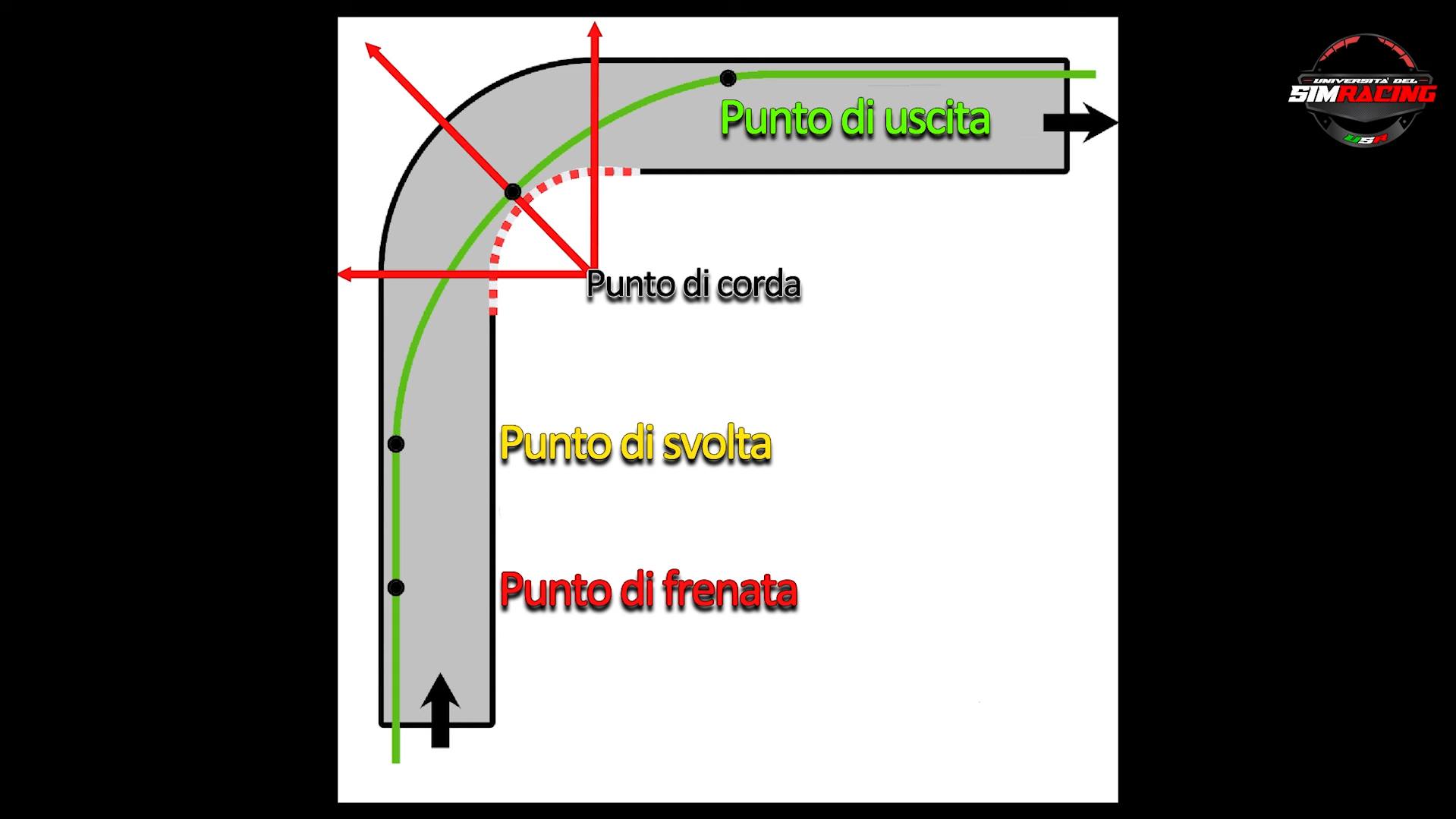
From this division, it’s clear that the three most important reference points are, in order:
- Braking Point
- Turn-in point
- Apex
- Exit Point

The goal is to navigate the corner by combining all three points, using a clean and smooth line, connecting them visually first and then physically.
Given the initial division, braking and turning are the most critical parts.
They determine:
- How the rest of the corner will be taken
- Where and how fast the car will reach the apex and the exit speed
This is where you start braking and then make the initial turn into the corner, the so-called trail-braking.
The turn-in point is determined by how and where you want to reach the apex.

The apex is the point of the corner where the inner wheels are closest to the inside of the track and will influence how and the speed at which the car will exit.
Determining if you’ve chosen the correct apex is simple.
If, when exiting the corner, you need to turn the wheel further to avoid going off-track, then you reached the apex too early.
Whether the apex is reached late, the car won't use all the track on the exit because it will be too inside.
In most corners, if after the apex, the driver does something different with the wheel other than realigning, they probably reached the apex too soon.
The basic rule is: don't turn the wheel further once you’ve passed the apex.
When you reach the apex, the car will naturally follow the line to the exit point.

The exit point is where the car runs closest to the outer edge of the track, exiting in the best possible way.
You need to use the entire track, barely staying on the edges, accelerating as much as possible.
This means you’ve hit the perfect apex.
If you need to lift off the gas to stay on track, it indicates an early apex.
If there’s still room available on the exit, the apex was too late.

Geometric Line vs. Ideal Line: Differences and Practical Examples with the Help of the Grip Circle

You can adjust the amount of time spent in each part of the Grip Circle using different lines in the same corner.
Let's take a constant radius corner as an example.
The geometric apex of a constant radius corner is the midpoint inside the corner and, depending on the circumstances, can also coincide with the ideal line’s apex.
In this case, it’s a classic racing line.
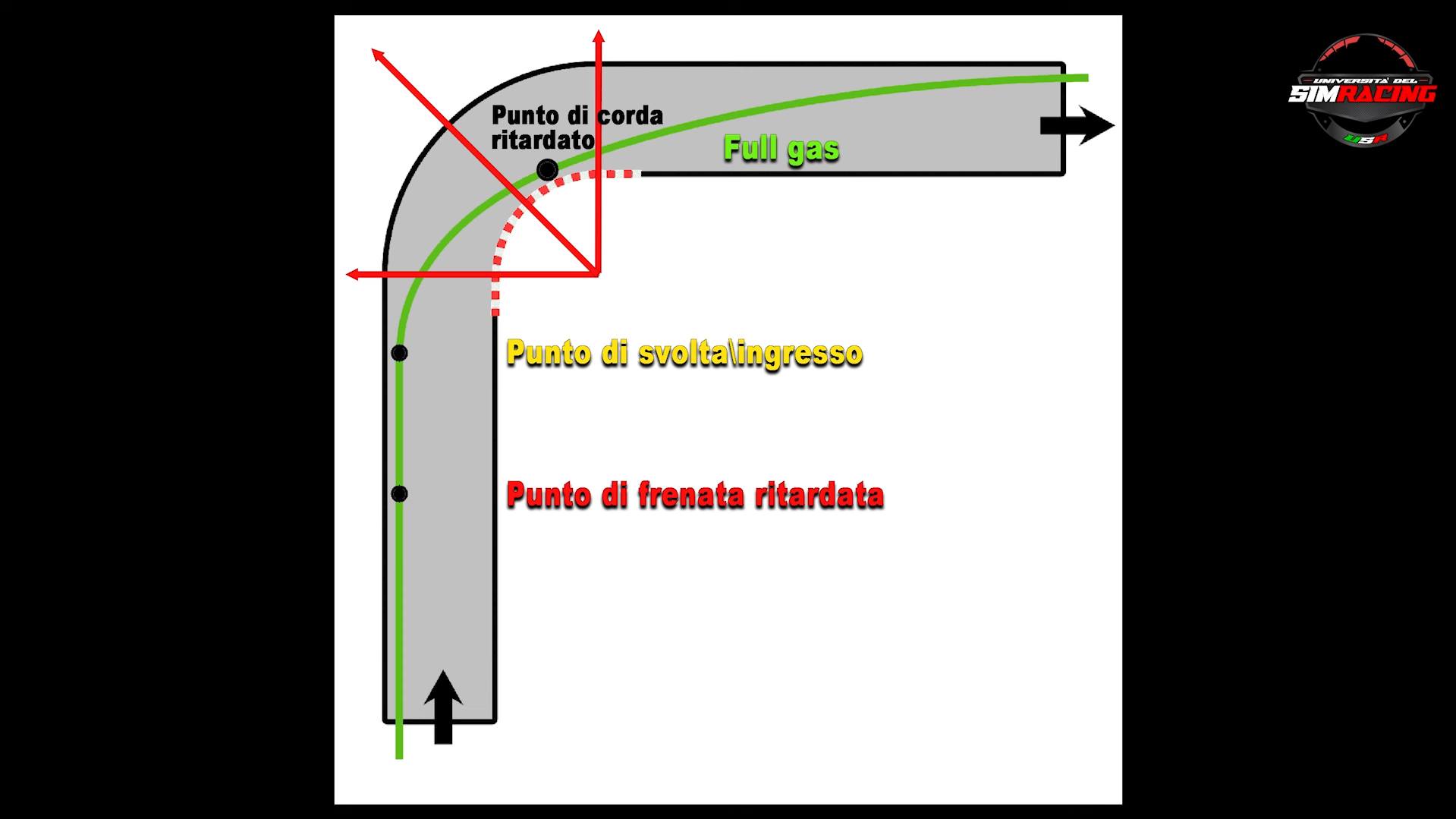
However, there are also corners where the apex can be at the beginning of the corner (early) or delayed (late), depending on what comes next.
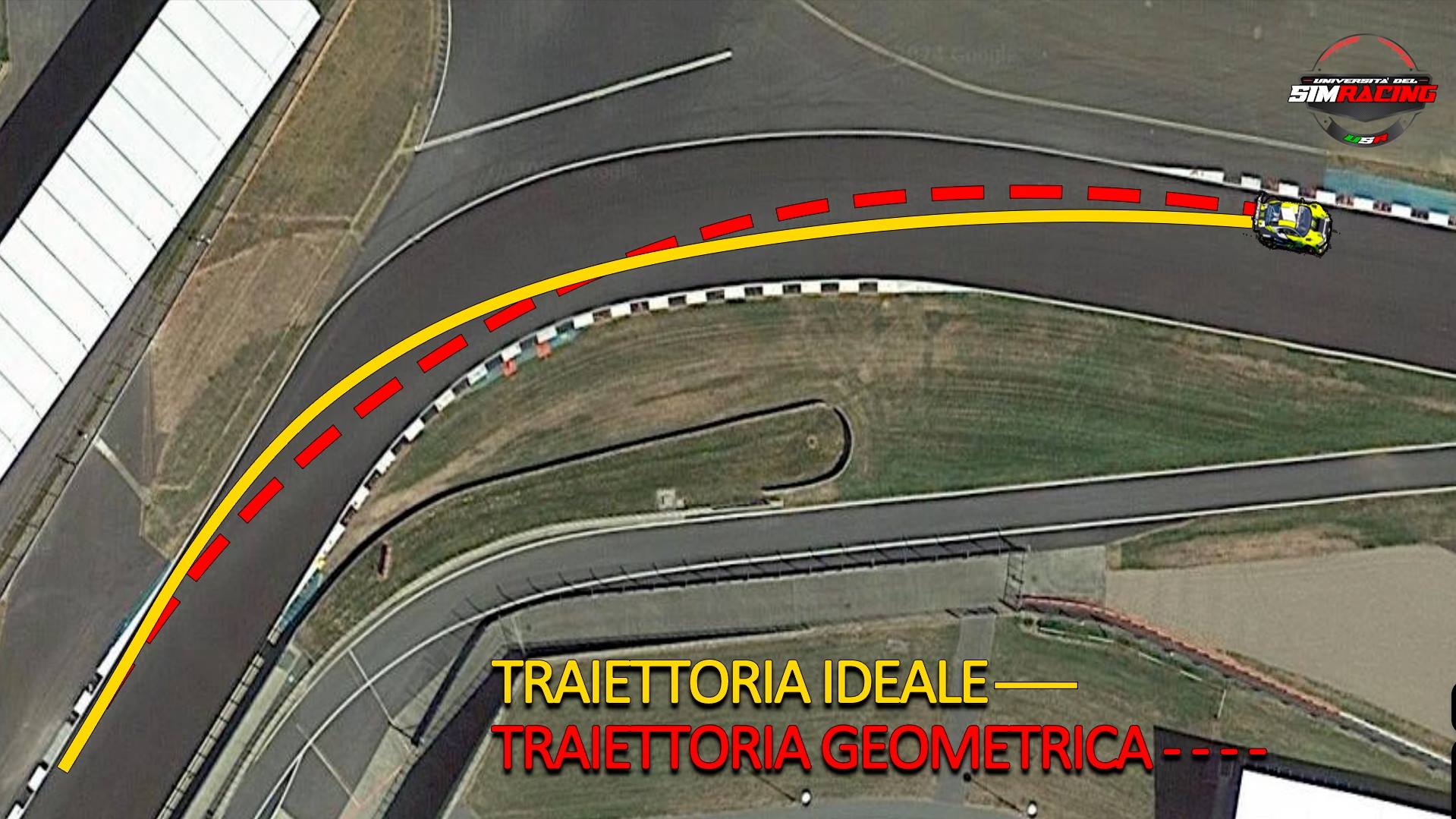
Suppose you’re approaching a corner that leads onto a straight.
The image shows two possibilities:
- Ideal Racing Line: marked with a solid line
- Geometric Racing Line, indicated by a dashed line.
The geometric line has a constant radius through the corner.
This is the fastest way to take this particular type of corner.
Advantages of the geometric line include:
- Smoothing out the corners most effectively
- Maintaining the car’s momentum on entry, reducing over/understeer, which is useful in wet conditions
However, there is a significant disadvantage: it doesn’t necessarily produce the fastest lap times.

The solid line in the image shows a modified line where the driver started turning later.
This line is tighter at the beginning but exits with a wider radius, expanding towards the next straight.
Second line, the solid one, is the ideal line.
Generally, following the ideal line results in faster hot laps.
The reason is simple.
As mentioned before, you’re not just dealing with a single corner but with a series of corners connected by straights of varying lengths.
Considering this, a higher exit speed is often more important than corner speed.
In essence, it doesn’t matter how fast the driver is entering the corner.
If everyone passes them on the straight, they’ll never win a race.
Remember, the driver who accelerates first out of a corner will reach the other end of the straight first and, most often, the finish line as well.

Therefore, in this case, the ideal line will have a delayed apex at about 2/3 of the way through the corner.
This allows the driver to accelerate early and carry more speed onto the straight.
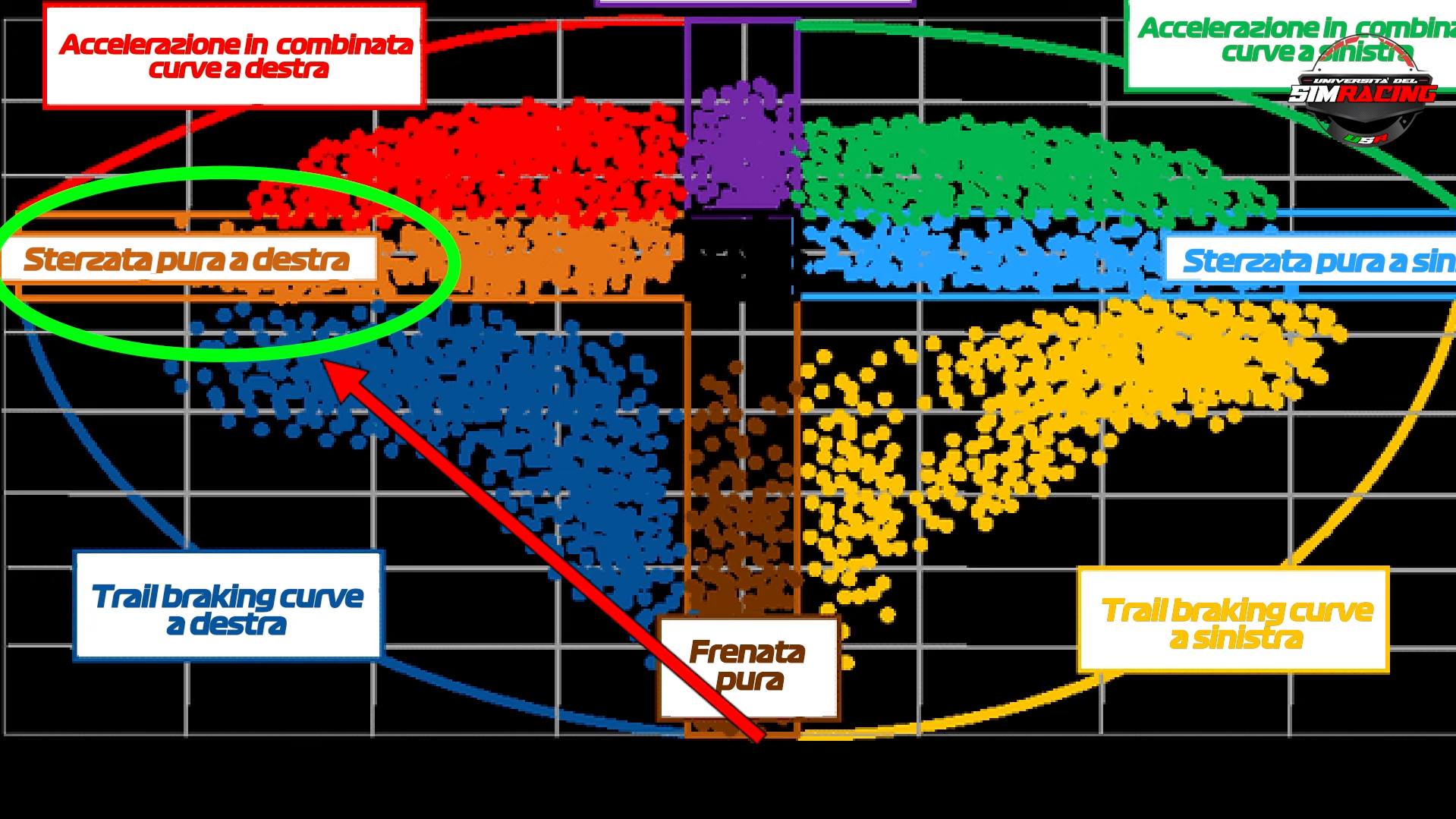
Returning to the Grip Circle
The driver following the geometric line in the previous image spends almost all the time at the limit of the "pure cornering" zone, maintaining a constant speed through the corner.
Since the driver can’t apply throttle if they’re using all the grip to corner, the geometric line won’t allow traction until the end of the corner and the start of straightening the steering.

On the other hand, the ideal line, with its tighter radius at the beginning, forces the driver to enter slower.
However, the expanding radius through the rest of the corner allows them to apply more throttle, resulting in higher exit speed.
This higher exit speed is used on the following straight, multiplying its effect and compensating for the slower entry speed.
With the ideal line, the driver spends much less time in "pure cornering" and more time at the limits of braking and acceleration.
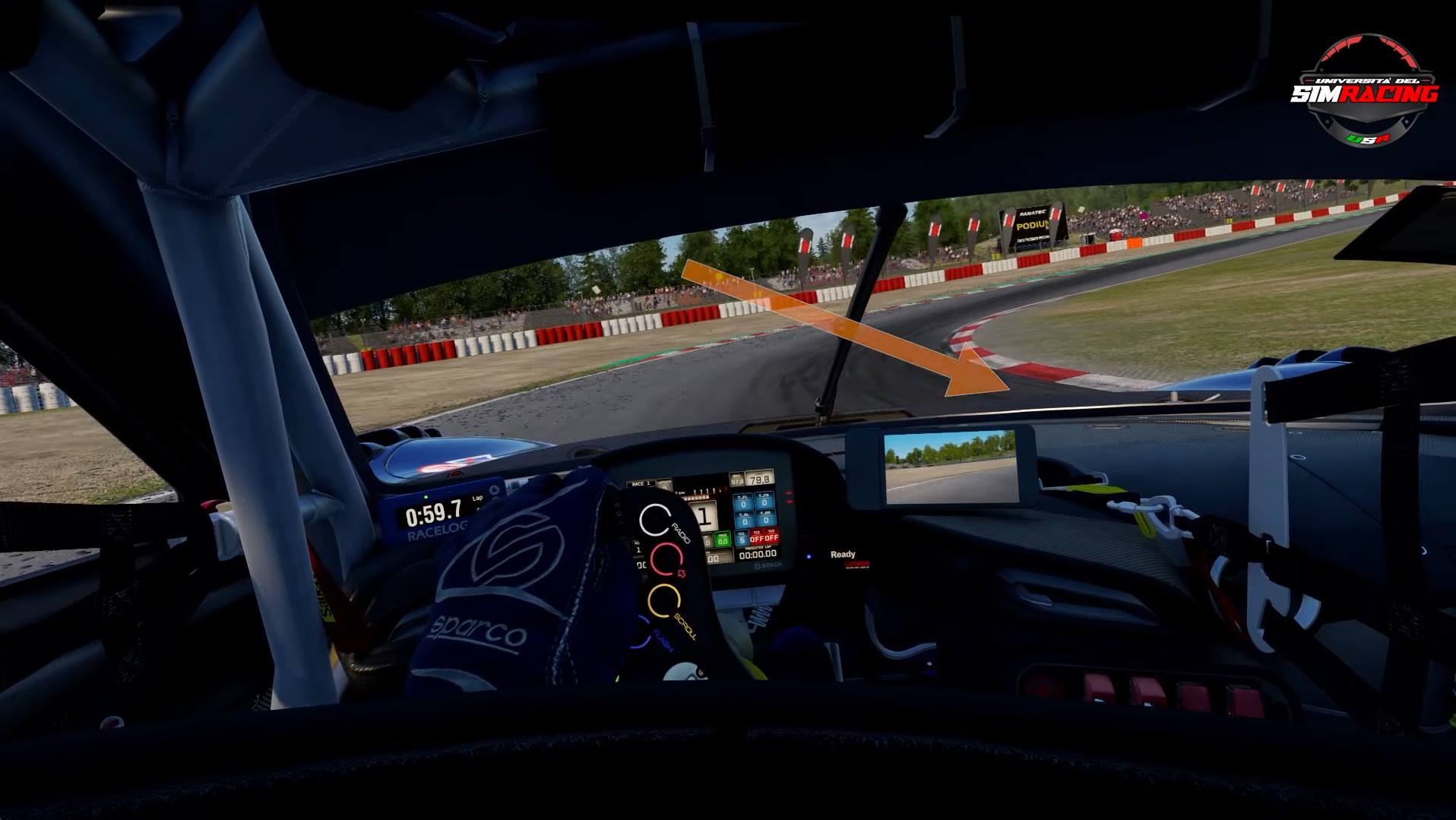
Determining how much to deviate from the geometric line is one of the most complex problems for a driver.
Changing it too much, turning late, reaching the apex late means that the initial part of the corner must be taken so slowly that the time lost there can’t be fully recovered on the following straight.
This results in a slower lap time.
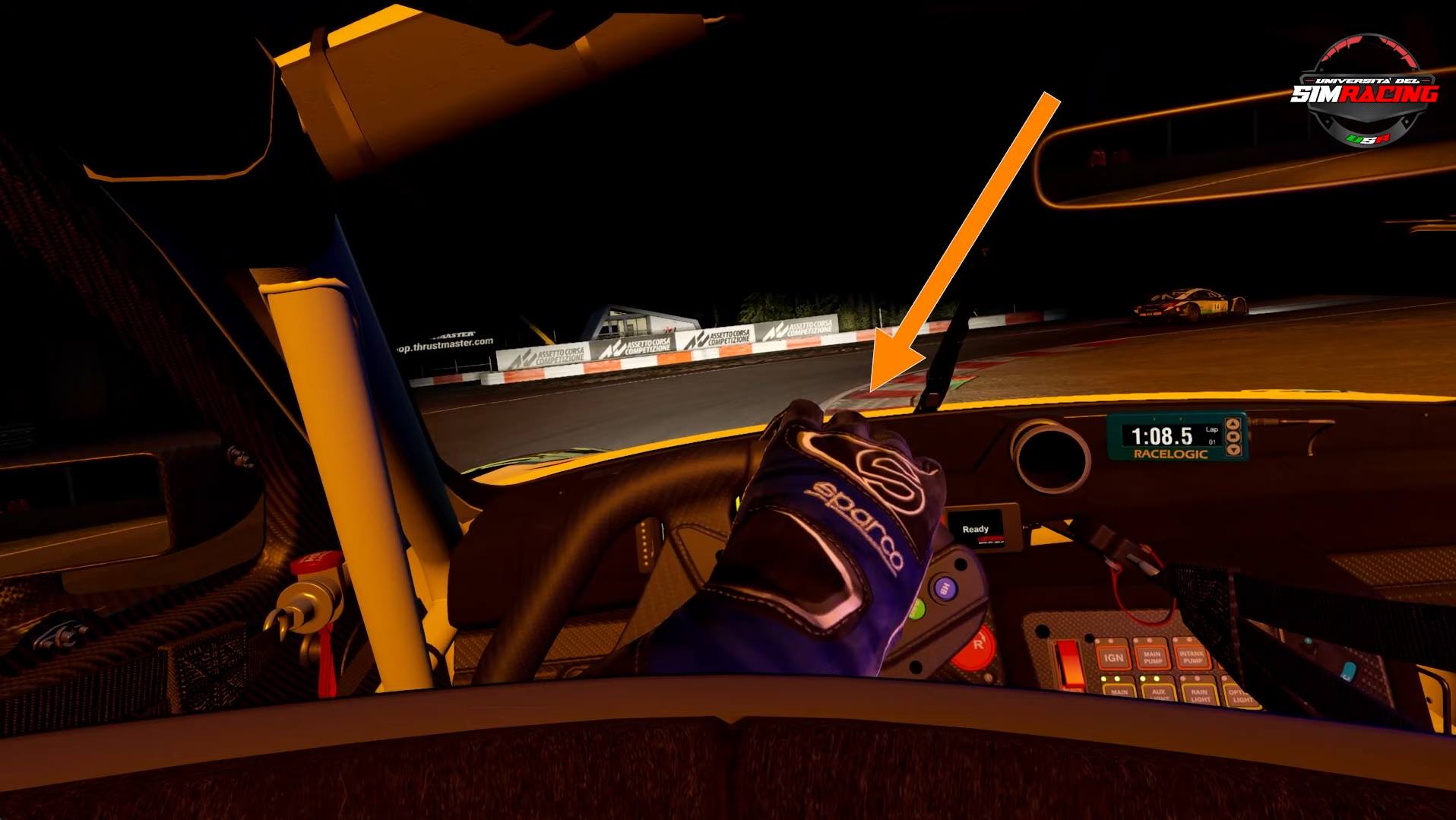
Conversely, not varying the line enough, turning and reaching the apex too early, reflects in the exit, with a slower car and less speed on the straight.
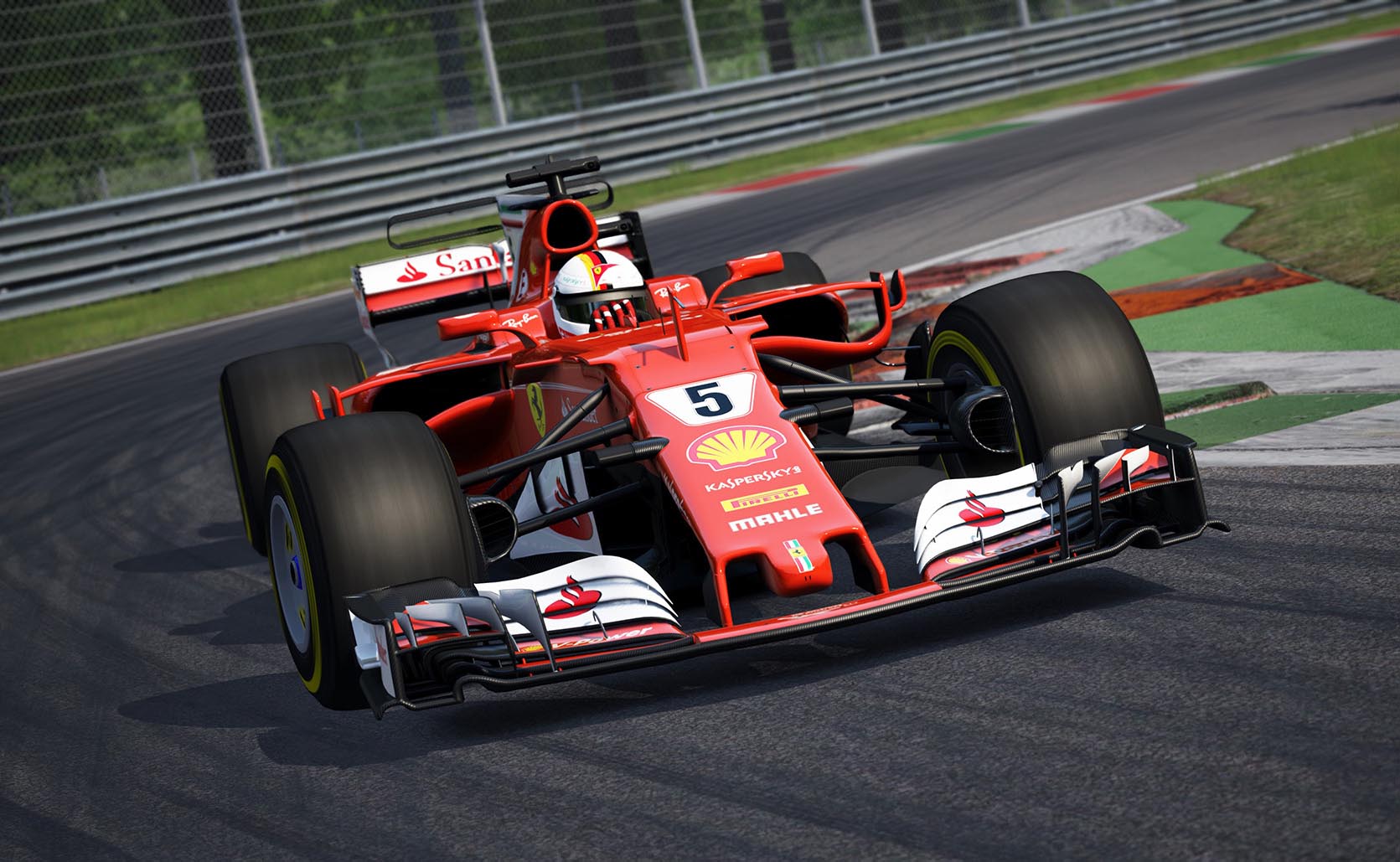
Important Concept
There isn’t one ideal line for all cars and corners.
The same car driven in different corners will require different lines, even for the same corner.
Different cars, like a Formula 1 and a GT3, will have varying needs.

Technically, the actual length of a corner goes from the turn-in point to where it’s possible to get back on the gas.
It’s clear that using a delayed apex results in less time spent cornering and allows for earlier acceleration.
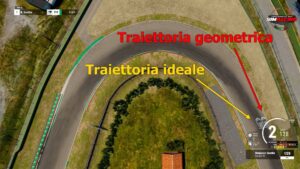
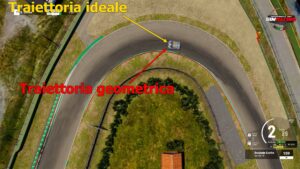
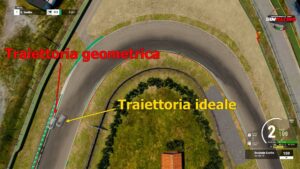
It's also noticeable how much earlier one can get back on the gas.

This brings more speed out of the corner using a non-geometric line.
However, this isn’t a hard and fast rule.
It depends on what follows the corner.
Generally, the shorter and tighter the corner and the longer the following straight, the more the line should be modified from the geometric one, with a delayed turn-in and apex.
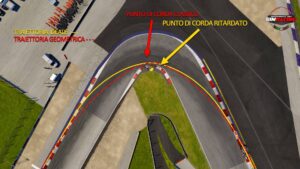
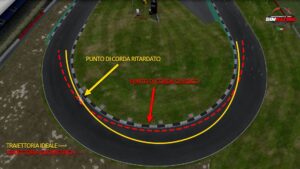
Many drivers fall into the habit of approaching every corner uniformly.
They can’t adjust their driving style to adapt to the varied conditions that different corners or cars present.
This is one reason why some drivers excel in driving a specific type of vehicle on a particular circuit but struggle when they switch to a different car or track.
A top driver knows how to adjust their line based on the track's features and the vehicle’s technical characteristics, always maintaining performance at the limit.
Some Corners Are More Important Than Others
Fast lap times and winning races come from knowing where to go fast and where to go slow.
When learning a track, focus on understanding which corners are the most important.
Generally, there are three types of corners:
- One that leads onto a straight
- One that ends a straight
- One that connects two other corners
Some believe that the most important corner for lap time is the one that leads onto a straight.
Second most important is the one that ends a short straight.
The least important is the one connecting two other corners.
The reasoning here is that it’s easier to overtake on a straight.
As mentioned, you spend more time accelerating than cornering on any track.
It’s more important to maximize speed on the straights to take advantage of all that time spent accelerating.
The corner that leads onto a straight will determine the speed achievable on that straight.
If the driver doesn’t start accelerating early, they’ll be slow on the straight.
This way of prioritizing corner types isn’t a bad starting point.
But if you want to win, there’s much more to it.
We must specify that there isn’t a written law for which there’s much more to gain or lose in the fast corners of a track rather than the slow ones.
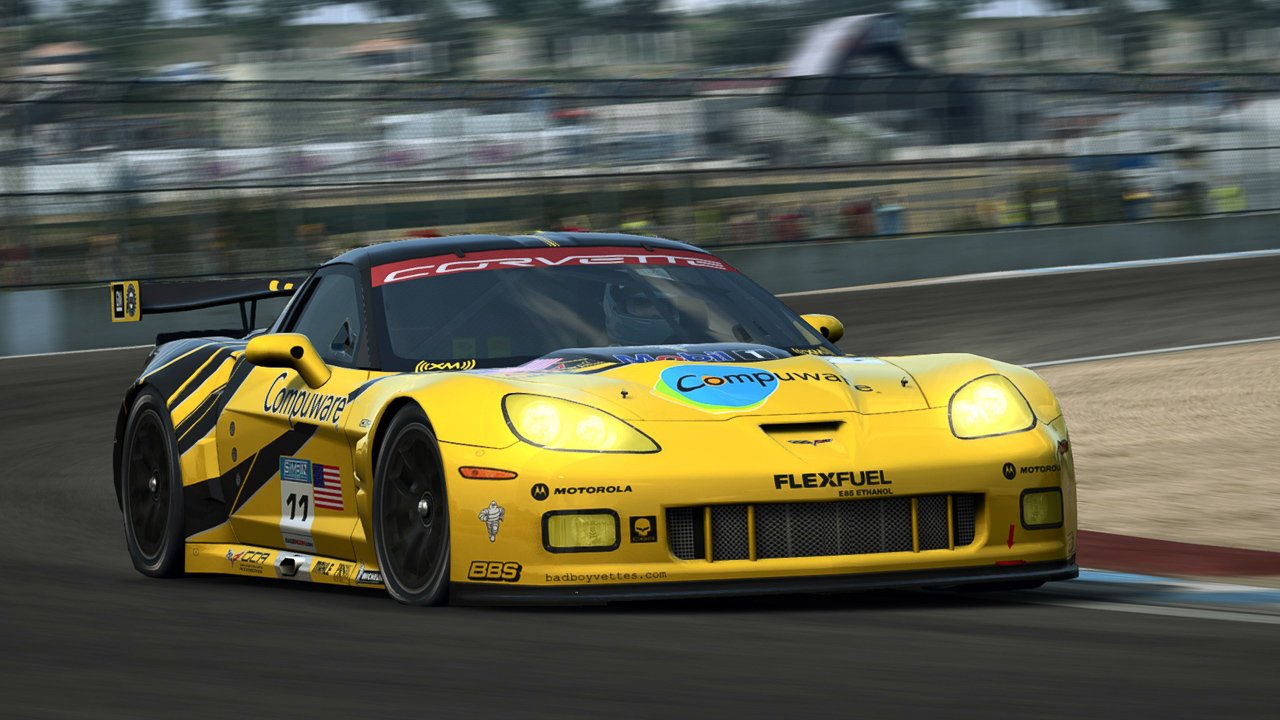
It also depends on the type of car being driven.
There’s a vast difference in available power, in terms of acceleration, and generally, between a GT, an F1, or a Hypercar.
An Example
Compare a slow corner taken at 60 km/h with a fast one taken at 170 km/h.
If we make a mistake and lose 10 km/h in the slow corner, it’s easy for our car, regardless of power, to accelerate from 50/60 km/h.
Whether we make a mistake in the fast corner, the car won’t accelerate from 160/170 km/h as quickly, especially if it doesn’t have high acceleration capability and significant power at medium-high speeds.
Analyzing the same data in terms of percentage, things change drastically.
Losing 10 km/h in a 60 km/h corner means losing 17% speed.
In a 170 km/h corner, losing 10 km/h equals less than 6%.
It’s clear that many drivers are intimidated by fast corners because a mistake at high speed can easily result in significant damage or even retirement...
...slow corners are where we spend more time in percentage on the lap-time.
So, it’s crucial to tackle them without making mistakes that would harm the lap-time.

Making a mistake in a fast corner that leads onto a long straight, despite the risk of severe damage, will cause us to lose much top speed, tenths on the lap-time, and expose us to overtakes if it happens in a race.
Early Apex for Straight-Ending Corners
When a straight ends in a corner not followed by another long straight to allow overtaking, an early apex is used.
Since there’s not much to gain on the exit, it’s more advantageous to maximize the benefit of a high-speed entry.
In other words, sacrifice exit speed to maintain the speed gained on the straight for as long as possible.

To do this, brake as late as possible, aiming for an early apex, using trail-braking.
The goal is to position the car optimally for whatever comes after the corner.

Series of Corners
A separate discussion is needed for composed corners, with two or more connected in series.
Here, the rule is to prepare best for the last corner that leads onto the straight.
Essentially, tackle it as you would any corner leading onto a straight, with a delayed apex.
The first corners in the series are important but should be used only to prepare for the last one.
Look at the image above. Enter corner A following a tighter line, sacrificing the exit line, staying more inside.
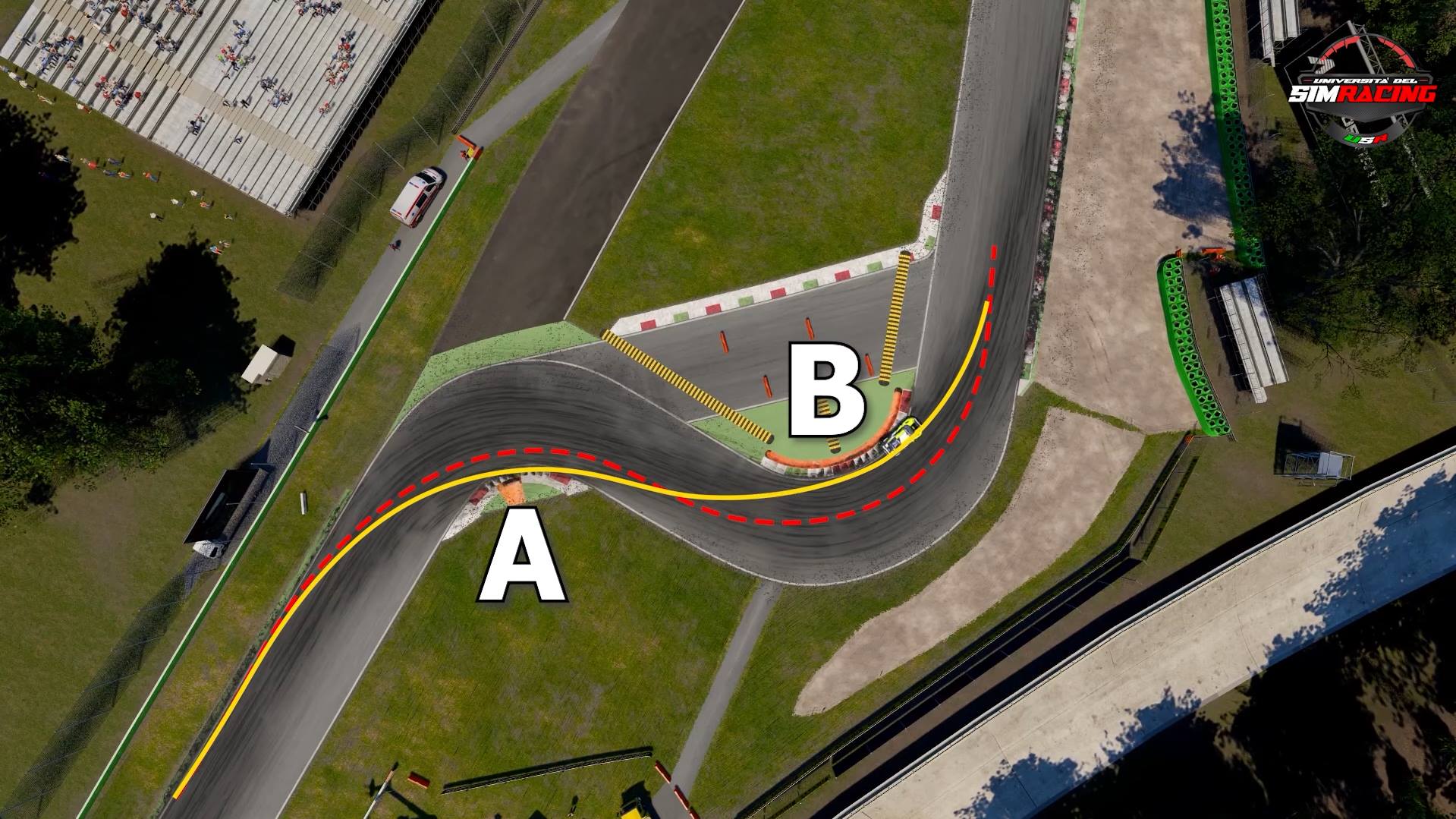
This way, you’ll be better positioned to tackle corner B, the one leading onto the straight.
Essentially, the ideal line for A is sacrificed in favor of B perfectly, exiting the series with the maximum possible speed.
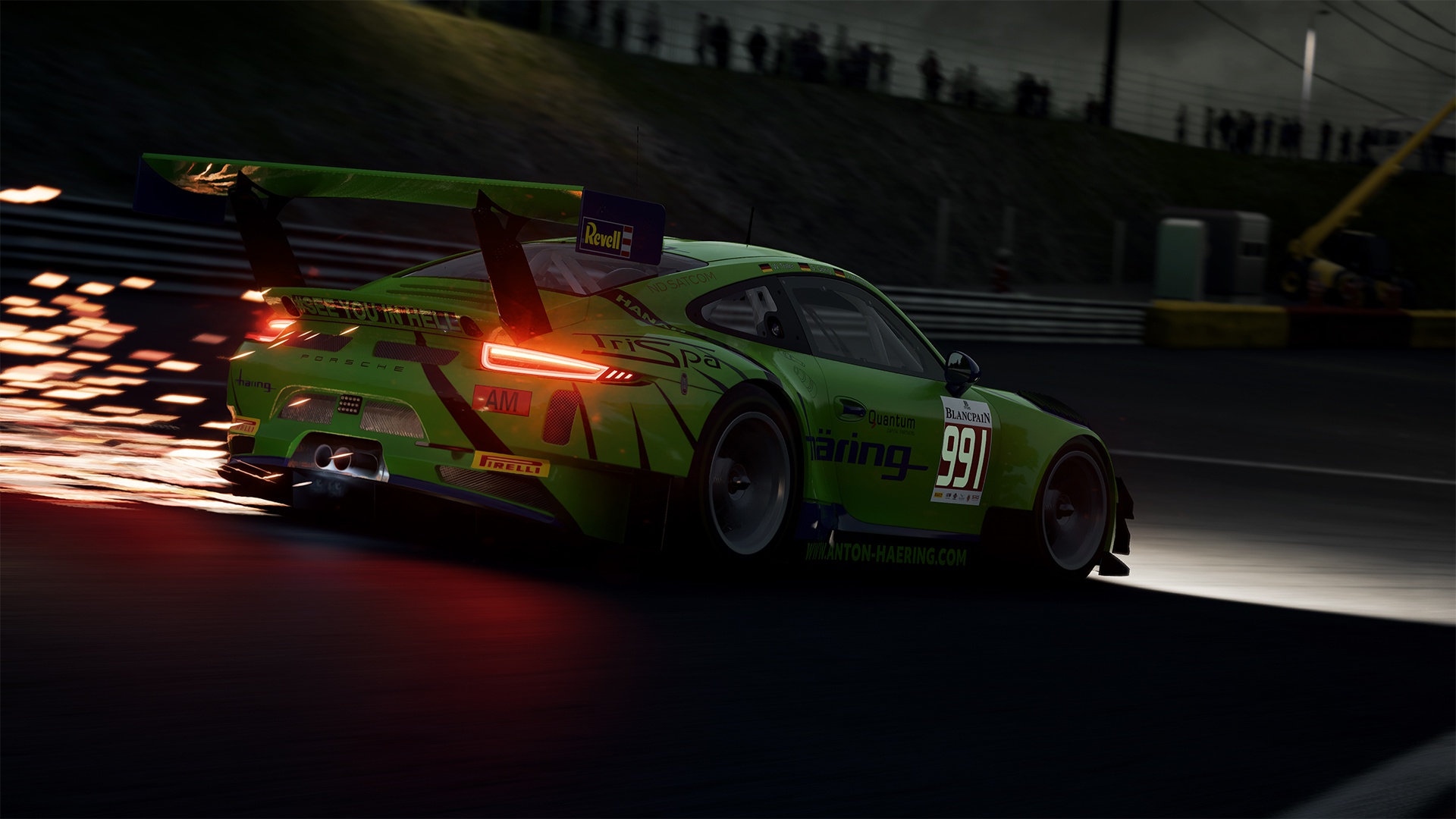
Ending
Being able to consistently choose the best ideal line distinguishes a good driver from a top driver, as well as the speed with which they enter a curve, navigate the mid-corner, and exit.
This might seem obvious, but it can only be achieved after perfecting the study of the ideal trajectory.
This study is not at all simple and goes beyond just the correct use of driving techniques.
But remember that being fast on a simulator is a slow, delicate, and exhausting process.
So, you must work hard and invest in yourself if you want to achieve the results you aspire to on the track and reach your goals.
On the track, you are NOT the employee, the lawyer, the butcher, the worker, the family man, or the student of everyday life.
You are a Driver, and as such, you must act, turning lap after lap with perseverance and dedication.
You'll see that the results will come if you adopt a Method, a System specifically studied and tested for YOU.
Imagine the thrill, the rush of adrenaline when you push your car to the limit and cross the finish line first in a race.
Imagine the happiness, the burst of pride and self-esteem you'll have when you achieve all your goals...
Watching yourself on the track, getting a Podium, or winning a Race.
Wouldn't it be great to be able to do everything you want on your own, like achieving pole positions and victories, winning championships?
So, join UniSimRacing.
We are Università del SimRacing, Italy's first Academy for Driving Simulators.
With over 15 years of experience in SimRacing, we have helped more than 1900 drivers revolutionize their driving style, with some reaching Esports championships.
Others have simply started having fun, improved their performance, and started winning races and championships.
If you really want to improve on Simulators, you're in the right place!
See you soon.
